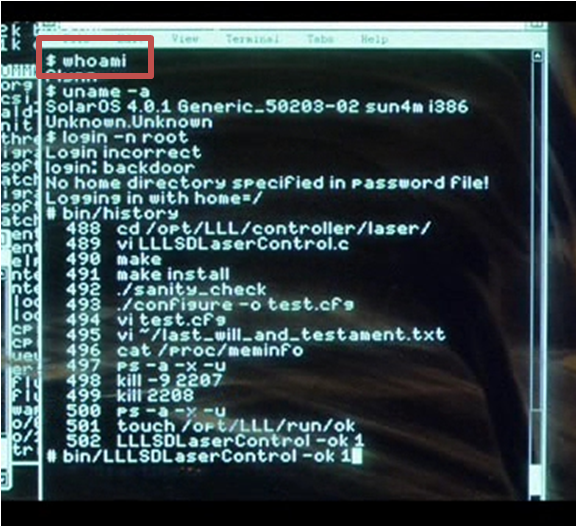TRON Legacy: the console prompt
A few evenings ago I was watching TRON Legacy with my son, and one short frame got my attention: the point when the Flynn’s son finds the father laboratory and the (supposed) Unix machine. Days after, I watched again the same sequence to better understand the commands on the console.
First of all, the operating system type: the SolarOS (which reminds the SunOS and its layer Solaris) was supposed to be an operating system produced by the Flynn’s Encom factory. What is quite strange is the architecture type: sun4m i386 is a mix between a Sparc machine and an Intel one, that is something that never existed! Apparently I was unable to find the
-n option for login, so I don’t know what a command like login -n root does, even if I can imagine it ask for logging as superuser. Moreover, I don’t see why the login should be incorrect without prompting for a password.
After that, a backdoor login is tried (?) and the user results in a superuser (according to the # shell prompt); this is also confirmed for not having a home directory, and that reminds me some old versions of SunOS that placed the home directory of the root user into the slash.
The commands from the history appears even stranger:

First of all, note that there is no executable named
history, that is a shell level built-in (at least in every shell I know of).
Second, it should appear quite awkward that the command chain is:
makemake installconfigure
vi ~/last_will_and_testament.txt
~ was a synonim for home directory only on recent shell, and not on a Bourne-like (as supposed to be in the old SolarOS computer back from 1985).
Moreover, I don’t see the point in having a multitasking system to compile and build and only after that editing a text file, I would have done it in the meantime. Last, I don’t see even the need for inspecting the available memory (cat /proc/meminfo), which reveals also a kind of Linux-based kernel.
Last but not least, all commands seem to be with a relative path and not the absolute one.
Nevertheless, I appreciate the effort in doing an almost coherent representation of a Unix system.